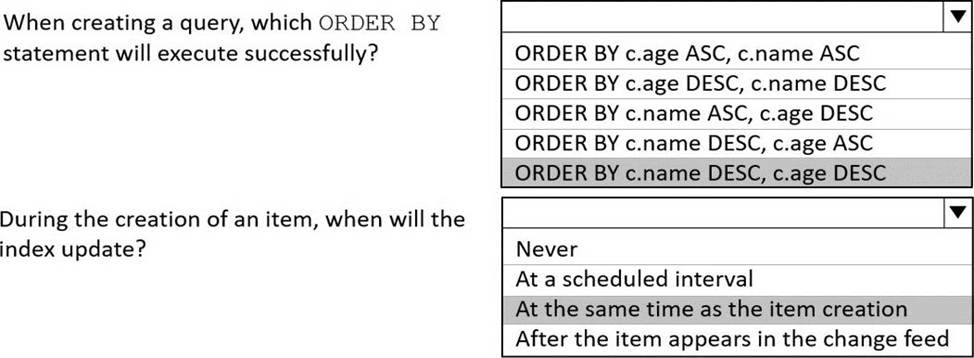Microsoft DP-420 Designing and Implementing Cloud-Native Applications Using Microsoft Azure Cosmos DB Online Training
Microsoft DP-420 Online Training
The questions for DP-420 were last updated at Apr 09,2025.
- Exam Code: DP-420
- Exam Name: Designing and Implementing Cloud-Native Applications Using Microsoft Azure Cosmos DB
- Certification Provider: Microsoft
- Latest update: Apr 09,2025
The settings for a container in an Azure Cosmos DB Core (SQL) API account are configured as shown in the following exhibit.
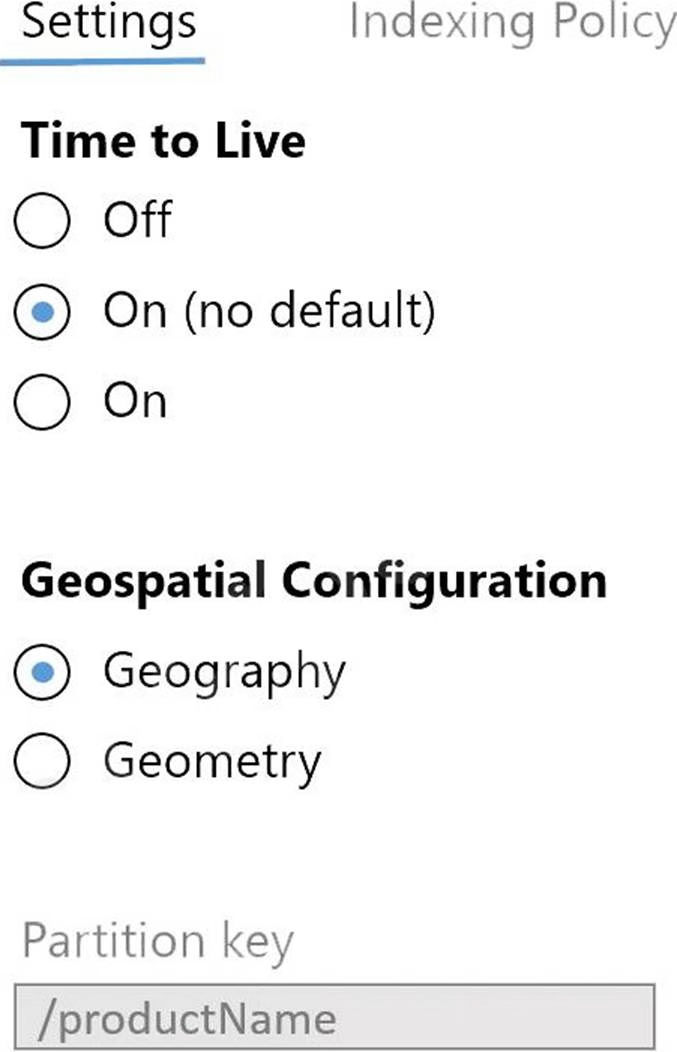
Which statement describes the configuration of the container?
- A . All items will be deleted after one year.
- B . Items stored in the collection will be retained always, regardless of the items time to live value.
- C . Items stored in the collection will expire only if the item has a time to live value.
- D . All items will be deleted after one hour.
You have an Azure Cosmos DB Core (SQL) API account that uses a custom conflict resolution policy.
The account has a registered merge procedure that throws a runtime exception.
The runtime exception prevents conflicts from being resolved.
You need to use an Azure function to resolve the conflicts.
What should you use?
- A . a function that pulls items from the conflicts feed and is triggered by a timer trigger
- B . a function that receives items pushed from the change feed and is triggered by an Azure Cosmos DB trigger
- C . a function that pulls items from the change feed and is triggered by a timer trigger
- D . a function that receives items pushed from the conflicts feed and is triggered by an Azure Cosmos DB trigger
The following is a sample of a document in orders.
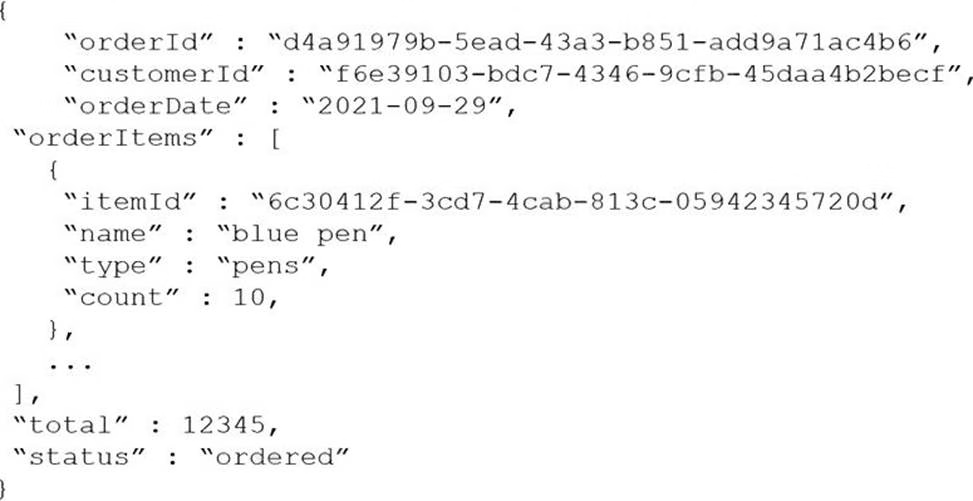
The orders container uses customer as the partition key.
You need to provide a report of the total items ordered per month by item type.
The solution must meet the following requirements:
Ensure that the report can run as quickly as possible.
Minimize the consumption of request units (RUs).
What should you do?
- A . Configure the report to query orders by using a SQL query.
- B . Configure the report to query a new aggregate container. Populate the aggregates by using the change feed.
- C . Configure the report to query orders by using a SQL query through a dedicated gateway.
- D . Configure the report to query a new aggregate container. Populate the aggregates by using SQL queries that run daily.
HOTSPOT
You have three containers in an Azure Cosmos DB Core (SQL) API account as shown in the following table.

You have the following Azure functions:
– A function named Fn1 that reads the change feed of cn1
– A function named Fn2 that reads the change feed of cn2
– A function named Fn3 that reads the change feed of cn3
You perform the following actions:
– Delete an item named item1 from cn1.
– Update an item named item2 in cn2.
For an item named item3 in cn3, update the item time to live to 3,600 seconds.
For each of the following statements, select Yes if the statement is true. Otherwise, select No. NOTE: Each correct selection is worth one point.

HOTSPOT
You configure Azure Cognitive Search to index a container in an Azure Cosmos DB Core (SQL) API account as shown in the following exhibit.

Use the drop-down menus to select the answer choice that completes each statement based on the information presented in the graphic. NOTE: Each correct selection is worth one point.

Note: This question is part of a series of questions that present the same scenario. Each question in the series contains a unique solution that might meet the stated goals. Some question sets might have more than one correct solution, while others might not have a correct solution.
After you answer a question in this section, you will NOT be able to return to it. As a result, these questions will not appear in the review screen.
You have a container named container1 in an Azure Cosmos DB Core (SQL) API account.
You need to make the contents of container1 available as reference data for an Azure Stream Analytics job.
Solution: You create an Azure Synapse pipeline that uses Azure Cosmos DB Core (SQL) API as the input and Azure Blob Storage as the output.
Does this meet the goal?
- A . Yes
- B . No
Note: This question is part of a series of questions that present the same scenario. Each question in the series contains a unique solution that might meet the stated goals. Some question sets might have more than one correct solution, while others might not have a correct solution.
After you answer a question in this section, you will NOT be able to return to it. As a result, these questions will not appear in the review screen.
You have a container named container1 in an Azure Cosmos DB Core (SQL) API account.
You need to make the contents of container1 available as reference data for an Azure Stream Analytics job.
Solution: You create an Azure Data Factory pipeline that uses Azure Cosmos DB Core (SQL) API as the input and Azure Blob Storage as the output.
Does this meet the goal?
- A . Yes
- B . No
Note: This question is part of a series of questions that present the same scenario. Each question in the series contains a unique solution that might meet the stated goals. Some question sets might have more than one correct solution, while others might not have a correct solution.
After you answer a question in this section, you will NOT be able to return to it. As a result, these questions will not appear in the review screen.
You have a container named container1 in an Azure Cosmos DB Core (SQL) API account.
You need to make the contents of container1 available as reference data for an Azure Stream Analytics job.
Solution: You create an Azure function that uses Azure Cosmos DB Core (SQL) API change feed as a
trigger and Azure event hub as the output.
Does this meet the goal?
- A . Yes
- B . No
HOTSPOT
You have the indexing policy shown in the following exhibit.
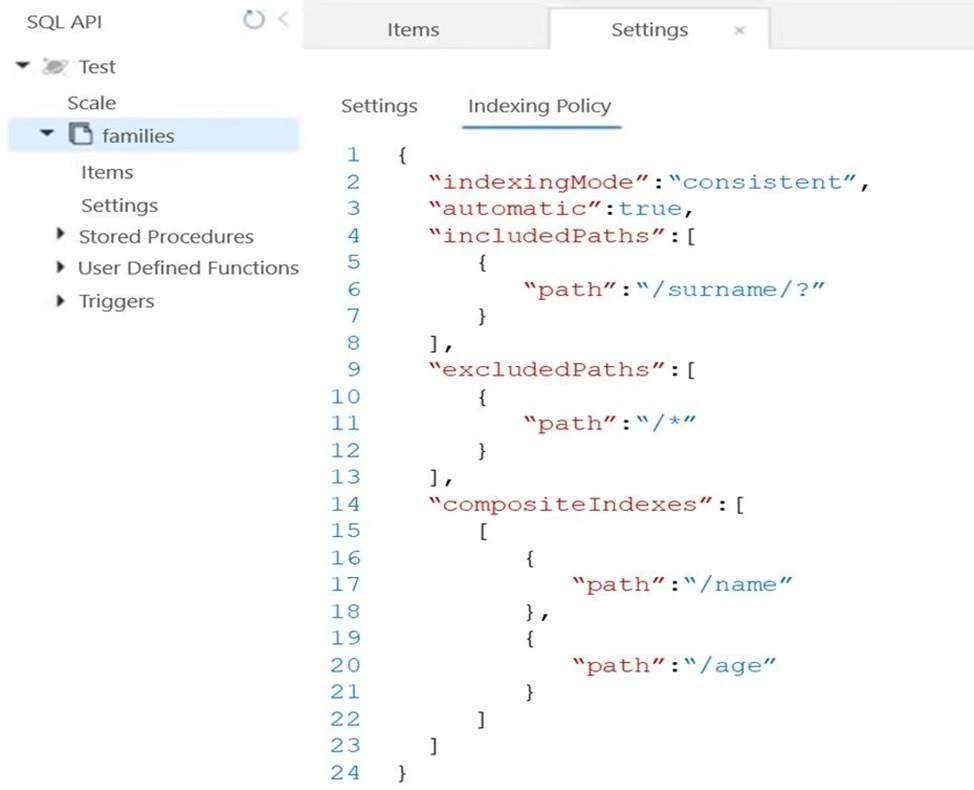
Use the drop-down menus to select the answer choice that answers each question based on the information presented in the graphic. NOTE: Each correct selection is worth one point.
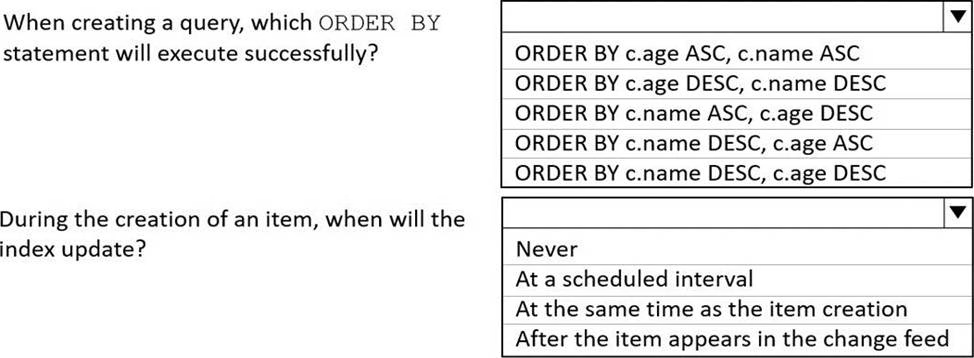
You have a container named container1 in an Azure Cosmos DB Core (SQL) API account. Upserts of items in container1 occur every three seconds.
You have an Azure Functions app named function1 that is supposed to run whenever items are
inserted or replaced in container1.
You discover that function1 runs, but not on every upsert.
You need to ensure that function1 processes each upsert within one second of the upsert.
Which property should you change in the Function.json file of function1?
- A . checkpointInterval
- B . leaseCollectionsThroughput
- C . maxItemsPerInvocation
- D . feedPollDelay
Latest DP-420 Dumps Valid Version with 51 Q&As
Latest And Valid Q&A | Instant Download | Once Fail, Full Refund






